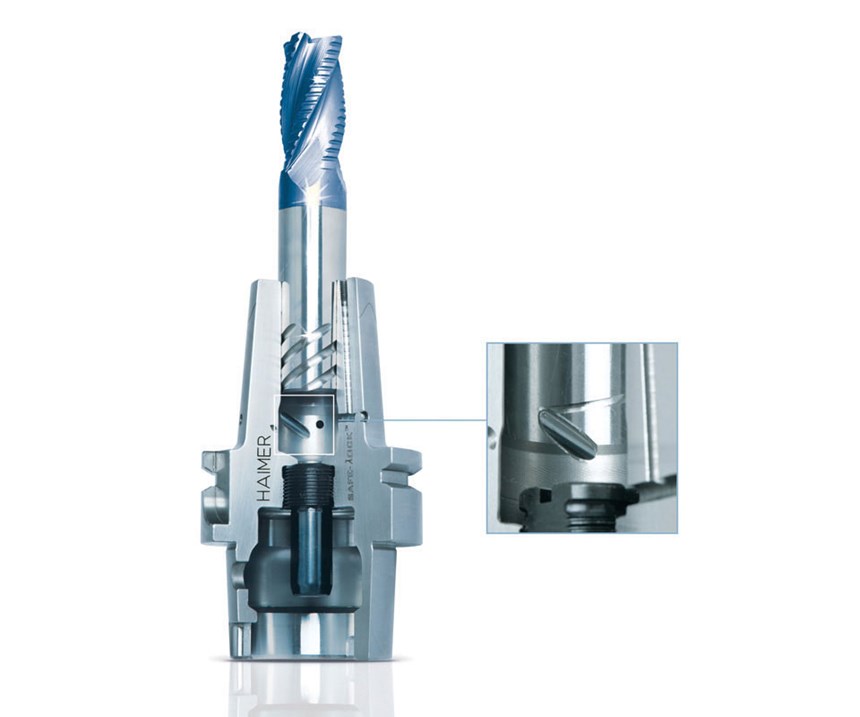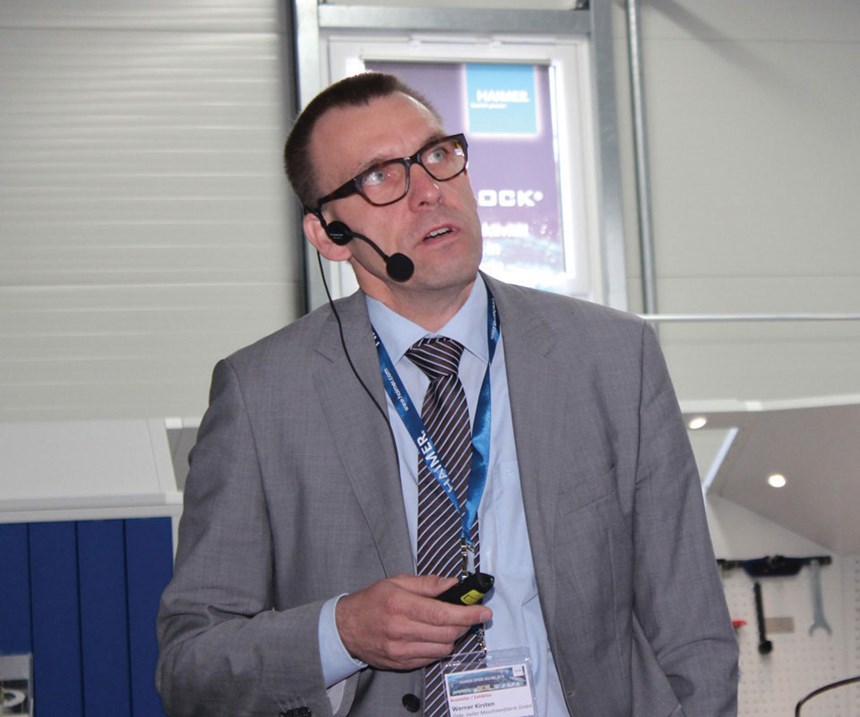Safe Tooling for Heavy Machining
Heavy machining puts stress on the tool holder. This system helps eliminate tool pullout.
The importance of the toolholder is often understated, especially when it comes to roughing and heavy duty machining where precision is considered less critical. Metal removal rates in these types of processes are absolutely crucial for the productivity of the machining operation. Using special shrink-fit chucks with drive pins and spiral grooves in the tool shank to secure the cutter/holder interface, high-feed full slotting of up to 2 × D (50 mm) can be performed in difficult to machine materials.
A toolholding system from Haimer USA augments the advantages of shrink-fit holders with pullout protection using drive pin and spiral groove design. Especially within the aerospace, energy and mechanical engineering sector, production managers have to bridge the gap between economic efficiency and high process reliability when working with materials that are difficult to machine.
All machining components in the process chain have to be considered in order to improve productivity. The machine tool is the most evident component of the machining process. However, the tool, the toolholding system, the coolant supply and other elements are also essential for a successful operation. In the end, the weakest link of the process chain limits the success.
In heavy milling operations, whether one is climb milling or using conventional feeds, the cutter can generate a pulling force on the toolholder. In a basic shrink-fit toolholder, which holds the cutter simply by frictional force, this pulling action can and sometimes does overcome the holder’s ability to grip the cutter. This can result in cutter pullout.
Classic shrink-fit holders, in part because of their superior concentricity and low runout, allow the machine tool to be run with aggressive speeds and feeds. However, since the shrink-fit grip relies on what is basically a smooth bore, those aggressive cutting speeds generate pullout in difficult to machine materials.
Generating a more reliable shrink-fit grip is a driver behind the Safe-Lock system that Haimer developed for addressing the pullout problem in its traditional shrink-fit toolholders. Basically, the company is able to offer a shrink-fit tool and a pullout (safe) shrink-fit tool based on the customer’s application.
Using the system requires the tooling companies to produce a spiral groove and receiver for the drive pin in the cutting tool shank. However, the holder can accept smooth shank tools as well.
From the onset of its creation, Haimer recognized the potential of the Safe-Lock system. With that in mind, the company created a licensing program to give innovative tool manufacturers the ability to integrate the pullout protection system into their tools. The result has created a more open system, which has been successful. To date, 14 leading cutting tool manufacturers have signed licensing agreements, including Walter, Widia, Sandvik Coromant, Seco Tools, Sumitomo, Kennametal, Helical, Emuge Franken, Data Flute, Niagara, OSG, Melin, SGS Tools and recently Mapal.
Through the steady increase of Safe-Lock toolholding systems in the market, Haimer and its licensed partners are seeing the system moving to become a defacto standard for heavy machining and roughing. And now, more and more companies that make use of the trochoidal (dynamic) milling strategy are also making the switch to Safe-Lock holders to prevent pullout.
During trochoidal milling operations, where the cutting speed and axial depth of cut can be increased through software support, productivity is significantly improved. However, the increased cutter engagement and cutting forces that result from the higher cutting performance create a situation where tool pullout can occur easily.
Prior to Safe-Lock, this problem was prevented with Weldon shanks and chucks. However, customers had to sacrifice speed and accuracy because of the nature of this clamping system. A shrink-fit chuck with Safe-Lock offers the same safety as the Weldon system, but provides the additional advantage of accuracy and balance. The ideal balancing and runout characteristics of the shrinking technology in combination with the clamping safety of the Safe-Lock system permit higher productivity achieved through faster permissible speeds and increased tool life all with complete tool security assurance.
To determine how best to apply the optimal toolholder, Haimer worked with German machine tool builder, Heller, to test its shrink-fit toolholder’s performance parameters. Heller is known for its high quality, four- and five-axis CNC machining centers, CNC mill/turn centers, CNC machines for crankshaft and camshaft machining as well as flexible manufacturing systems.
Werner Kirsten, who works in the Technology Development Department at Heller and is responsible for the area of “difficult to machine material,” says, “Our service includes optimizing the machining processes together with our customers and suppliers. To support such services with practical trials, our Technology Center is equipped with a variety of machines.”
In most cases, the aim is to increase the productivity without compromising the process reliability. Despite these additional limiting factors, the tool was able to process a full slot of 2 × D = 50 mm with complete process reliability.
Mr. Kirsten says, “This way we were able to indirectly prove that Safe-Lock works and that the shrinking technology has even more potential with HSK-A100, especially on five-axis machining centers with gear spindles.” Afterward, this sample machining on Ti-6AI-4V was carried out various times, whereby it was proven that the previous limit of 1 × D = 25-mm full slotting in titanium could be doubled with the use of Safe-Lock systems.
“For roughing operations, this is a reliable process. Therefore, I consider the Safe-Lock system a practical, easy to handle and process reliable addition to the shrink-fit technology, which we already utilize, especially in connection with standardized tools of other manufacturers,” Mr. Kirsten says.
Related Content
The Value of Tool Monitoring on Rotary Transfer Machines
By using a tool monitoring system, shops can save costs associated with machine maintenance and downtime for tool changes while increasing cutting performance.
Read MoreParting Off: The Case for Standardizing on Sawing
The value of rotary saw cutting for parting off operations could boil down to simple economics paired with process efficiency gains.
Read MoreMicromachining Fundamentals
A number of elements must come together to establish an effective process for machining at a micro level. Here we consider four.
Read MoreProducing Micro Screws for the Watch Industry
Cutting tools play a key role in machining tiny screws on Swiss-type lathes for this Switzerland-based watch manufacturer.
Read MoreRead Next
Emerging Leaders Nominations Now Open
Here’s your chance to highlight a young person in your manufacturing business who is on the path to be a future leader moving your company forward.
Read More5 Aspects of PMTS I Appreciate
The three-day edition of the 2025 Precision Machining Technology Show kicks off at the start of April. I’ll be there, and here are some reasons why.
Read MoreA Tooling Workshop Worth a Visit
Marubeni Citizen-Cincom’s tooling and accessory workshop offers a chance to learn more about ancillary devices that can boost machining efficiency and capability.
Read More

























